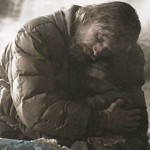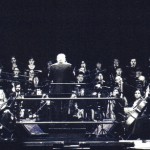“Do not be afraid,” I tell myself. “He’s still in the boat.”
These are momentous times for the Church. Changing one’s shepherd under normal circumstances is already an historic, life-changing event. Add in the wrinkle of searching for a new shepherd as the last one is still settling into his new (and still very much earthly) home, however, and the term “momentous” begins to feel inadequate.
Yet as Benedict XVI’s papacy fades, I find myself strangely, distressingly detached.
I have read the heart-felt thoughts of my fellow bloggers with sympathy and with gratitude. I have studied the prognostications and wish lists with interest and with my own hopes and desires for their accuracy. But write something myself? That, I cannot do. Despite my own reactions earlier this month, and despite the many reflections I have seen since that day, I must admit with sorrow that I have nothing to say.
I’m ashamed of this response. It manifests a failure on my part — a failure to recognize how significant Benedict’s papacy was, how profound his love for the Church, and how deeply his departure will affect all of us. I took Papa Benedetto for granted — as I do so many of the immeasurable blessings in my life — and that failure stings.
I know that I will miss him. And I am grateful. Yet his resignation never felt strange to me. I want to feel bereft today as the doors of Castel Gandolfo hide him from our view; truly, I do. It’s unsettling to me that this feels “right” (for Benedict, at least) rather than “wrenching.” But I’m not troubled by his departure.
I am troubled by something, though; deeply so. And today’s events make that abundantly clear:
I hate not having a pope.
This sede vacante stuff? This “captain-less barque on the storm-tossed sea” feeling that is neither living nor dying? This is weird to me; this is wrenching. And it’s scary.
Earlier today, I realized that this conclave will be only the second such event my sons will experience. I also realized that it’s only the second one that I can remember, as well. And “two” is nowhere near enough times for something like this to feel normal.
Like many of my fellow Generation-JPIIers, Blessed John Paul’s longevity spoiled me. For years, the prospect of selecting a new pope was nothing but an abstract concept, and when the time came to elevate Benedict to the papal seat, the long, painful decline of his predecessor’s health brought with it an obviousness and inevitableness that helped to lessen the blow.
 But today, as I wait with my fellow Catholics for the Easter-time arrival of our new vicar, I am undeniably anxious. It’s not that I fear for the conclave’s outcome: I don’t have a papabilical horse in this particular race. No matter whom the cardinals elect, I’ll be satisfied — but not because I believe their selection is infallible, or because I think that the potential pontiffs are “all winners in my book.” No, it’s because what I frantically, desperately want is a papa, and I’ll settle for anyone, just as long as he fills this pope-shaped tear in my soul.
But today, as I wait with my fellow Catholics for the Easter-time arrival of our new vicar, I am undeniably anxious. It’s not that I fear for the conclave’s outcome: I don’t have a papabilical horse in this particular race. No matter whom the cardinals elect, I’ll be satisfied — but not because I believe their selection is infallible, or because I think that the potential pontiffs are “all winners in my book.” No, it’s because what I frantically, desperately want is a papa, and I’ll settle for anyone, just as long as he fills this pope-shaped tear in my soul.
This is a childish response, I know, and little more than a spiritual tantrum. I stamp my foot and demand: “I want a pope, and I want him NOW!” But it’s because I’m afraid of being alone.
Then I recall Christ’s calming of the storm from Mark’s Gospel (referenced so beautifully by Benedict himself this past Wednesday), and I am reminded of the thing that always amazes me most: in the midst of their fear, as the apostles called out despairingly for relief from their suffering, Christ wasn’t just listening to their pleas or waiting nearby lest they needed rescuing. He was there with them. He was in the boat.
I understand the fright and the franticness of the apostles all too well at this moment, and the stormy seas feel very near. But they were not alone in their trials, and neither am I. “Don’t be afraid,” I say to myself. “He’s in the boat.”
He’s always in the boat.
Attribution(s): Photos courtesy of Getty Images, which allows the use of certain images “as long as the photo is not used for commercial purposes (meaning in an advertisement or in any way intended to sell a product, raise money, or promote or endorse something).” “Christ in the Storm on the Lake of Galilee” by Rembrandt via Gardner Museum (Home, Info, Pic). Licensed under Public Domain via Wikimedia Commons.












